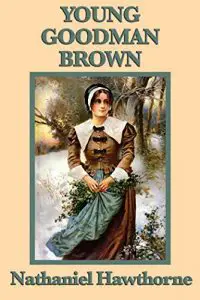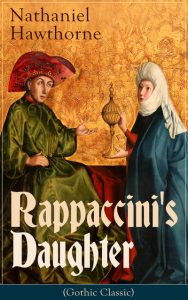The last decade of the 18th century to the last decade of the 20th century was known as the period of Romanticism. It was a time when authors wrote of self-exploration and examining how people fit into the larger society. Authors used their writing as a way to connect characters quests and journeys to find their self to that of their audience. Romanticism used nature and human nature to show the inherent good within the world. Dark Romanticism focused on the inherent bad elements of nature and human nature as well as destruction and death.
Elements Of Dark Romanticism
Elements of Dark Romanticism can be found in the works of American writers like Nathaniel Hawthorne and Edgar Allan Poe. These elements include an emphasis on the supernatural, a focus on human fallibility, and a dark or morbid worldview.
 One example of Dark Romanticism can be found in Nathaniel Hawthorne’s short story “Young Goodman Brown.” In this tale, Young Goodman Brown leaves his wife Faith at home as he goes off into the woods to meet with a mysterious figure. He soon discovers that this figure is the Devil, and that all of the people he thought were good and honest are actually evil. This story shows the fallibility of human beings, as well as their capacity for evil.
One example of Dark Romanticism can be found in Nathaniel Hawthorne’s short story “Young Goodman Brown.” In this tale, Young Goodman Brown leaves his wife Faith at home as he goes off into the woods to meet with a mysterious figure. He soon discovers that this figure is the Devil, and that all of the people he thought were good and honest are actually evil. This story shows the fallibility of human beings, as well as their capacity for evil.
Another example of Dark Romanticism can be found in Edgar Allan Poe’s short story “Rappaccini’s Daughter.” In this tale, a young man named Giovanni falls in love with a beautiful girl named Beatrice. However, he soon discovers that she is the daughter of Rappaccini, a scientist who has been experimenting with poisonous plants. Beatrice is immune to the poison, but anyone who touches her will die. This story shows the dark side of human nature, as well as the dangers of science and technology.
 Nathaniel Hawthorne’s “Young Goodman Brown” and “Rappaccini’s Daughter,” along with Elizabeth Stoddard’s “The Prescription” focus on self exploration through through the methods of both Romantics and Dark Romantics as well as through the obstacles in their lives. Hawthorne’s writing can be argued as having characteristics of Romanticism and Dark Romanticism; however his writing more often is considered to be Dark Romanticism due to his use of religion and death. In both “Rappaccini’s Daughter” and “Young Goodman Brown” the main characters ultimately die without reaching their ideal happy ending.
Nathaniel Hawthorne’s “Young Goodman Brown” and “Rappaccini’s Daughter,” along with Elizabeth Stoddard’s “The Prescription” focus on self exploration through through the methods of both Romantics and Dark Romantics as well as through the obstacles in their lives. Hawthorne’s writing can be argued as having characteristics of Romanticism and Dark Romanticism; however his writing more often is considered to be Dark Romanticism due to his use of religion and death. In both “Rappaccini’s Daughter” and “Young Goodman Brown” the main characters ultimately die without reaching their ideal happy ending.
Characteristics Of Dark Romanticism
Dark romanticism is a literary genre that emerged in the early 19th century. It was characterized by its focus on the dark, mysterious, and supernatural elements of life. Young Goodman Brown and Rappaccini’s Daughter are two examples of dark romantic literature.
Some common characteristics of dark romanticism include:
– A focus on the dark, mysterious, and supernatural elements of life
– A preoccupation with evil and sin
– A belief in the inherent goodness of humans
– A focus on human emotion and psychology
– A concern for social reform
– An emphasis on nature and the natural world
– A focus on the individual and the inner self
– A focus on beauty and aesthetics.
Beatrice, Rappaccini’s daughter died after being given a dose of antidote to cure her of her poisonous self, ” That lovely woman…. had been nourished with poison from her birth upward, until her whole nature was so imbued with them, that she herself had become the deadliest poison in existence. Poison was her element of life” (160). Hawthorne used nature in a negative way, showing how beauty can turn evil. Nature not only played the setting, but as a way to express mortality. All things must die; whether it be people, animals, or plants. Beatrice directed showed that connection upon her death.
Her death represented that nothing except God has the power of immortality and that trying to stop the inevitable only leads to negative consequences. Stoddard on the other hand is claimed to be a Romantic writer. Her story “The Prescription”, shows a gentler side of nature. The Bowman’s house sat right on the sea’s border, but continued to stand, “Below the creek stretched the beautiful bay of Marlow, and beyond that rolled the ocean over which Mr. Bowman’s mind went on his old voyages” (298). Fuller only sees the beauty within the ocean. She does not see the harm that it causes.
This positive outlook is a hallmark characteristic of a Romantic’s work. While Hawthorne and Stoddard represent two different writing styles they had much in common. Both authors featured nature in their stories, regardless of the connotation, and nature had an influence on the character’s outcome. In Hawthorne’s case, Beatrice became poisonous from the flowers. Stoddard uses the ocean as a change of scenery and a literal and figurative breath of fresh air to help Caroline find herself. One of the biggest similarities between Hawthorne and Stoddard is not their writing, but the obstacles they had to overcome.
Hawthorne had to overcome his infamous family history, while Stoddard had to fight the gender barrier just because she was a female writer in the 1800s. Nathaniel Hawthorne was the great great grandson of one of John Hathorne, one of the most infamous judges during the Salem Witch Trials that took place in Massachusetts from 1692-1693. Salem during that time was governed as a religious theocracy. Sarah E. Jones wrote in her article “Holy Hysteria” that, “The Massachusetts Bay Colony had been founded as a sort of Puritan utopia free from heretical interference, and Salem, like all Massachusetts settlements, enforced religious law” (19).
Hawthorne family history of Puritanism is very prominent in his stories. Hawthorne used negative light on church to show his distrust in organized religion, but continues to show that he considered faith to be necessary. Hawthorne’s piece “Young Goodman Brown” featured a man who went into the woods in search of himself. Following his adventure, Goodman Brown quickly noticed that Faith, his wife had gone missing, ironically enough along with Brown’s spiritual faith, “There is no good on earth; and sin is but a name” (116). Faith was later found at the church, but his spiritual faith was nowhere to be found.
Upon his death, he still lacked a spiritual connection and when buried, “they carved no hopeful verse upon his tombstone; for his dying hour was gloom”(121). Ideally Brown’s funeral would have a strong religious connection that clearly showed his journey to Heaven in his afterlife, but instead there was not. Throughout Goodman Brown the reader can learn how religion and self exploration are similar. Many turn to religion as a way of finding one’s self. Brown attempted to do that; however when he lost all sense of spirituality, he also lost himself.
He no longer found joy in his life. It is said that, “Often, awaking suddenly at midnight, he shrank from the bosom of Faith, and at morning or eventide, when the family knelt down at prayer, he scowled, and muttered to himself, and gazed sternly at his wife, and turned away”(120-121). Brown used to find comfort within his wife and within prayer. Now he turned away from both and can no longer stand being with his wife. Brown’s search for himself only led him to become a new, hateful person. Hawthorne’s distrust in religion is extremely evident in this piece.
He used religion as a way to ruin a life and show a lack of growth that ideal would have been present. Stoddard also had relatives from Salem and was even distantly related to Hawthorne, but she did not have the same effects that he faced as noted in “The “Possessed” Reassessed: Elizabeth Stoddard’s The Morgesons, the Salem Witchcraft Hysteria and Literary (Anti)Nationalism” (Abate 47). Stoddard was more concerned with the limitations of being a woman in the 19th century than her ties to the Salem Witch Trials. In that era women were frequently under the control of their husbands.
Luckily Stoddard’s husband approved and supported her career since he was a poet and understood her desire to write. Elizabeth Stoddard’s “The Prescription”, much like Hawthorne’s stories also has a strong sense of self-identification and exploration seen through Caroline Fuller’s experience. Fuller is experiencing what would today be diagnosed as depression. Also, Fuller’s husband displays characteristics that may be considered to be abusive. In one instance he rips Caroline’s jacket off in front of the doctor, prompting the doctor to prescribe that she spend some time away.
Fuller stays on the sea-coast with an elderly couple whose company she enjoys. Fuller explains that she feels free, “All at once I felt better in spirits; my clothes seemed to belong to me more than they had for a long time, and a strange sense of freedom stole over me when I recollected that I could keep the candle burning as long as I pleased, and sit up all night if I saw fit” (298). This new found freedom was just what Fuller and her doctor were hoping for. Fuller contemplates not returning to her husband.
Fuller tells Mr. Bowman that she is looking for the ideal man but Bowman tells Fuller that it is possible to have an ideal that doesn’t turn out perfectly, “”Did you ever have an ideal, Caroline, that you were disappointed in utterly? ” (305). Caroline thought about what Bowman said and decided to make up with her husband, accepting his faults and becoming less judgemental of him. Stoddard’s ending differs greatly from the endings of other authors in the 19th century. Contrary to killing off a character, Stoddard has Fuller reconcile with her husband, leading to a much happier ending due to the absence of death and Fuller’s successful self-exploration.
Stoddard’s ending while praised at the time of publication may not be considered a happy ending today. In the 21st century, we recognize that it was not the wife’s behavior which needed to change to heal the abusive marriage, but the husband’s. However, back in the 19th century that behavior would not be unusual and his action would be blamed on the woman for angering the man; therefore Fuller’s choice to return to her husband would be accepted. This may lead to modern readers disagreeing over whether the story is an example of Romanticism or Dark Romanticism, but the other characteristics are clearly Romantic.
Romantics and Dark Romantic authors have many similarities in their styles of work that are representative of their time period. However, Hawthorne and Stoddard vary greatly in how they end their stories, their use of nature, and the growth or lack thereof experienced by the characters. Hawthorne explored the darker side of self-discovery, and frequently had unhappy endings. Stoddard started with an unhappy situation, and through the healing power of nature, allowed her character to find her way to a–hopefully– happy ending.